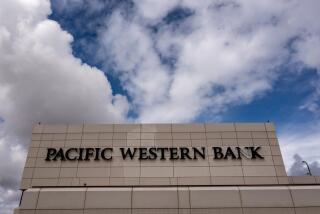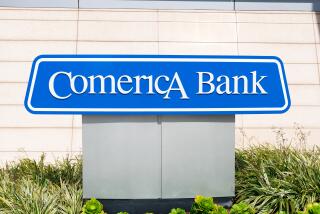Mergers Add Up to Historic Shift for U.S. Banks : Finance: A fragmented industry consolidates as loan demand shrinks. Relaxed laws are also driving the trend.
- Share via
NEW YORK — Like a giant PacMan game, U.S. banks are swallowing each other at a furious pace spurred by high stock prices, lackluster demand for loans and an overabundance of lenders in the first place.
About 450 bank mergers, worth about $14 billion combined, have been announced in this third year of merger mania, according to figures from Securities Data Co. That is not counting the mega-deal, announced Monday, to fuse Keycorp and Society Corp. into the nation’s 10th-biggest banking company. That merger, valued like the others as an acquisition, would be worth about $4 billion.
The mergers are profoundly reshaping U.S. banking, which has been characterized by extreme fragmentation due to a suspicion of big banks that dates back at least to Andrew Jackson.
“What’s been driving all the mergers is excess capacity,” said Donald Delson, managing director at Alex. Brown & Sons Inc., a securities brokerage firm. “There are too many players, too many people.”
Thanks to decades-old regulations limiting bank growth, the United States has far more banks than any other industrialized nation. As those laws are relaxed and bank holding companies become more aggressive, the number of U.S. commercial banks has shrunk from about 13,100 to 11,300 in the last five years, largely due to mergers and acquisitions.
Cost cutting has been a major impetus behind such mega-mergers as the 1991 pairing of California giants BankAmerica Corp. and Security Pacific Corp., or the fusing of Manufacturers Hanover Corp. and Chemical Banking Corp. in New York.
While cost considerations are still important, the latest wave of mergers is gaining momentum from soft loan demand and rising stock prices, which give institutions more clout in acquiring each other through stock swaps.
“There aren’t any loans out there. People are afraid” to borrow because of the uncertain economic recovery, said Linda L. Stromberg, director of bank equity research at Howe Barnes Investments Inc. in Chicago.
At the same time, banks have recently enjoyed record profits and rising stock prices. They are benefiting from historically huge spreads between the interest they pay on checking and savings accounts and the interest they receive on loans.
But banks recognize that the large spreads won’t last forever, analysts said.
“Once you had the peaking of margins and a lack of robust loan growth, there was an increased appetite for mergers in the industry to find new revenues,” said Diane Glossman, bank analyst for Salomon Bros.
The merger between Albany, N.Y.-based Keycorp and Cleveland-based Society is unusual in that the banks are seeking to expand into new markets, rather than eliminate overlapping offices and staff in one area.
In addition, the deal was advertised as a merger of equals, not a larger institution devouring a smaller one.
But analysts said Keycorp is not alone in seeking a Midwestern partner. Midwestern banks have fewer problem loans than many California or Northeastern banks, which have been hit hard by the collapse in real estate prices.
In addition, many Midwestern states are only now relaxing decades-old limits on bank branches. Illinois, for example, with 1,100 commercial banks, just eliminated all restrictions on bank branches within the state.
“None of the major players have really penetrated the Midwest much at all,” said Richard L. Huber, vice chairman at Continental Bank in Chicago.
Some of this year’s biggest deals involve Midwest banks. Some of the announced deals include Milwaukee-based Marshall & Ilsley Corp. and its purchase of another Wisconsin institution, Valley Bancorp.; Bancone of Ohio’s acquisition of Firstier Financial Inc. of Nebraska, and Chicago-based ABN AMRO North America buying Cragin Financial Corp. of Chicago.
While many mergers have involved small banks, the big boys are steadily getting bigger.
In the first half of this year alone, the top 100 U.S. bank holding companies increased their assets by $124 billion, or 5%, according to a survey by American Banker, a trade publication. About half of that was due to mergers.
Stromberg said many banks are scrambling to find allies as they envision the industry dividing into two tiers: large banks with regional or national reach, and small banks with strong traditions of service to their communities.
“Everyone wants to feel, after this musical chairs, that they’ll have a chair,” she said.
More to Read
Inside the business of entertainment
The Wide Shot brings you news, analysis and insights on everything from streaming wars to production — and what it all means for the future.
You may occasionally receive promotional content from the Los Angeles Times.










